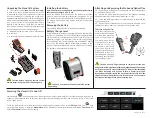
DESIGNER’S HANDBOOK 4189350049C EN
Page 21 of 206
3.3.8
NMEA serial data output (7a and 7b)
XDi with an NX1 or NX2 interface attached has the ability to transmit some predefined NMEA serial data
sentences. For example, rudder angle to a VDR (voyage data recorder). The XDi-N version can route NMEA
sentences from one of the NMEA inputs to one of the outputs.
3.3.8.1 Share NMEA input data on CAN
All data types receiving data from an NMEA input can also be setup to share those data on XDi-net.
The XDi-net setup can be changed from the NMEA setup menu in the installation menu system. Use the manual
NMEA setup sub-menu.
NMEA data will be shared at the same update rate as they are received. If NEMA input data is received every 100
millisecond, then XDi-net data will also be sent every 100 millisecond.
NMEA data can also be shared in a standard CANopen TPDO, but in that case the VS profile used for the selected
virtual indicator must have a predefined TPDO output function included.
If TPDO output support is not mentioned in the description of the VS profile for a given virtual indicator, this function
will not be available. It is however always possible to include this in a customised library.
3.4
Change selected input via menu
Inputs for indicators and dimmer input are always predefined as one of the 6 input types described and with
parameter pre-sets stored in the respective VI-setup profile (VS) or Product Profile (PP).
In general, a new profile should be defined for every new combination of inputs.
Well-designed setup profiles makes it very easy afterwards to set up the XDi during installation, simply because all
setup parameters are loaded when the basic installation wizard is completed and only some small fine adjustments
may be needed via the installation menu.
3.5
Multi sources and automatic fall-back
In most cases each indicator element in a virtual indicator has a single data source, but in XDi software platform 2 it
is made possible to use the fall-back function to make up to 3 input sources available for a given indicator element.
This function can handle all normal 16bit data types and is not restricted to XDi-N but can also be used in XDi-M
and with some limitations in XDi-D that can only handle 2 inputs. The function was originally made for handling
some types of navigation data where a fall-back from a main source to a backup source can be relevant.
It is also in DEIF standard navigation libraries that this function at present is used, but it can also be useful in
different types of customized solution where a need for selectable data sources or a fall-back to a backup source is
needed.
The functionality is illustrated in the sketch below, where 3 instances of wind direction data is coming from 3 wind
sensors are routed via the Fall-back switch to the indicators wind direction pointer.
















































